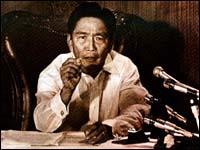
Forty-one years ago this week, September 21 to be exact, then President Ferdinand E. Marcos placed the entire country under Martial Law. Martial Law conjured up visions of tanks and guns, human rights violations, silenced free press, tortured activists, confiscated businesses, imprisoned oppositionists, suspended constitution, violent demonstrations, politicized military and dead bodies of activists hastily buried in shallow graves.
To borrow a line from “A Tale of Two Cities” by Charles Dickens, it was the worst of times.
Indeed, the declaration of Martial Law on September 21, 1972 remains to be one of the darkest episodes in Philippine history that should never be forgotten.
Martial Law was a grand design crafted by Marcos and his cohorts to create a new political landscape in the Philippines. With the stroke of a pen, he abolished the constitution and imposed martial rule. The military was politicized and became Marcos’ hatchet men. A new group of political cronies emerged, with each crony in control of a particular product or industry: coconut under Eduardo Cojuangco, Jr; sugar, Roberto Benedicto; banana, Antonio Floirendo; manufacturing, Herminio Disini, to mention a few. Industries and companies were taken over by the Marcoses or their cronies, like the Philippine Long Distance Company (PLDT), the Manila Electric Company (MERALCO), and the media conglomerates owned by the Lopezes.
And how about the ill-gotten wealth of the Marcoses? It was reported in 2004 that Marcos’ loot in 1989 was estimated at US $16 billion including compounded interests. In 2012 the Presidential Commission on Good Government (PCGG) reported that it had so far recovered only P94 billion of Marcos’ ill-gotten wealth with a lot more still to be recovered. For every passing day, as the Marcoses continue to regain their political power, recovery of their ill-gotten wealth will become more difficult.
Marcos ruled by decrees and clamped down on any form of opposition. There was no space for sensible political discussions. People were generally afraid of the government and the military. In his book Dark Legacy: Human Rights Under the Marcos Regime, Alfred McCoy estimated that the number of people incarcerated during the martial law years reached 70,000; extrajudicial killings, 3,257; number of people tortured, 35,000; disappeared (desaparecidos) between 1975 – 1985, 737.
But as an astute student of history, Marcos failed to anticipate the collective reaction of the people against his oppressive regime. The people did not take Marcos’ iron fist sitting down. They formed legal and illegal organizations and confronted the Marcos dictatorship in all forms of struggles. Students, workers, farmers, religious, educators, fisher folks, urban poor, politicians, and other sectors united in what is now known as “People Power Revolution” in 1986 to drive away Marcos into exile in Hawaii.
Many Filipinos today below 50 years old have no direct experience of what it means to live under Martial Law. I was told that the history of Martial Law is only peripherally taught in schools, sans critical discussions on how it literally destroyed and plunged the county into chaos. I have a sneaking suspicion that the so-called Martial Law “babies” don’t know the many stories associated with Martial Law. Very few, I suspect, will remember the atrocities committed by the Metropolitan Command (METROCOM), the staged ambush on Juan Ponce Enrile before the declaration of Martial Law, the 200 paintings worth millions allegedly stashed by an aide of Imelda Marcos in New York, the ill-gotten wealth accumulated by the Marcoses, the sacrifices of many students a good number of them lost their lives, Marcos asking advice by phone from U.S. Sen. Paul Laxalt before abandoning Malacanang at the height of the first People Power, etc. People have to be told about these stories because, as warned by George Santayana, those who cannot remember the past are condemned to repeat it.
Which brings me to what Sen. Bongbong Marcos, son of the late dictator, posted in his Facebook account almost a year ago: “…Sure, there are lessons to be learned from the past and it is obvious that Martial law, and all the succeeding administrations for that matter, was neither “a bed of roses nor a bed of nails,” to paraphrase Bon Jovi’s lyrics. That’s all I will say on the Presidency of my father and those that came after. I will resist indulging in the blame game and continue to look forward ….”
What an audacious way for the dictator’s son to compare the brutal regime of his father with the succeeding administrations. It smacks of ignorance. It smacks of historical distortion. It’s revisionism at its best.
Let’s take the PNoy administration. I would bet my soul that no one, with a very few exception, who experienced what life was during Martial Law would trade PNoy’s administration with that of Marcos’. But statements similar to that of Bongbong’s can cloud the issue if people are not taught about the history of Martial Law in a critical way.
Bongbong’s statement presages a doomed future for us if we forget and not learn.










Leave a Reply